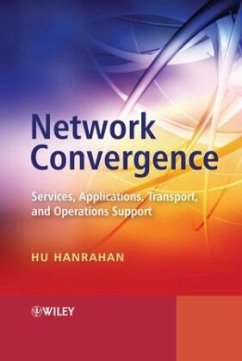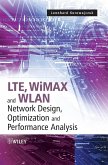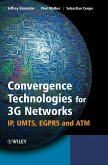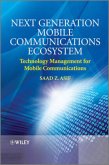- Gebundenes Buch
- Merkliste
- Auf die Merkliste
- Bewerten Bewerten
- Teilen
- Produkt teilen
- Produkterinnerung
- Produkterinnerung
Das Buch schafft eine solide Grundlage für das Verständnis der Netzwerke der nächsten Generation, ihres Potenzials bei der Unterstützung neuer und verbesserter Anwendungen und ihrer Verbindung mit herkömmlichen Netzwerken. Die Herangehensweise ist eher analytisch als beschreibend. Telekommunikationssysteme basieren auf Standards; das Buch analysiert und erklärt die Konzepte und Prinzipien solcher Standards für Netzwerke, Dienste und Anwendungen. Der analytische Ansatz eignet sich zur Bewertung und zur Diskussion von Design, Integration und Betrieb dieser Technologien in Netzwerken der nächsten Generation.…mehr
Andere Kunden interessierten sich auch für
![Lte, Wimax and Wlan Network Design, Optimization and Performance Analysis Lte, Wimax and Wlan Network Design, Optimization and Performance Analysis]() Leonhard Korowajczuk (Hrsg.)Lte, Wimax and Wlan Network Design, Optimization and Performance Analysis189,99 €
Leonhard Korowajczuk (Hrsg.)Lte, Wimax and Wlan Network Design, Optimization and Performance Analysis189,99 €![Convergence Technologies for 3g Networks Convergence Technologies for 3g Networks]() Jefrey BannisterConvergence Technologies for 3g Networks148,99 €
Jefrey BannisterConvergence Technologies for 3g Networks148,99 €![6LowPAN 6LowPAN]() Zach Shelby6LowPAN90,99 €
Zach Shelby6LowPAN90,99 €![Convergence Convergence]() Christian SaxtoftConvergence63,99 €
Christian SaxtoftConvergence63,99 €![Broadband Wireless Communications Business Broadband Wireless Communications Business]() Riaz EsmailzadehBroadband Wireless Communications Business102,99 €
Riaz EsmailzadehBroadband Wireless Communications Business102,99 €![Cellular Technologies for Emerging Markets Cellular Technologies for Emerging Markets]() Ajay R. MishraCellular Technologies for Emerging Markets115,99 €
Ajay R. MishraCellular Technologies for Emerging Markets115,99 €![Next Generation Mobile Communications Ecosystem Next Generation Mobile Communications Ecosystem]() Saad Z. AsifNext Generation Mobile Communications Ecosystem125,99 €
Saad Z. AsifNext Generation Mobile Communications Ecosystem125,99 €-
-
-
Das Buch schafft eine solide Grundlage für das Verständnis der Netzwerke der nächsten Generation, ihres Potenzials bei der Unterstützung neuer und verbesserter Anwendungen und ihrer Verbindung mit herkömmlichen Netzwerken. Die Herangehensweise ist eher analytisch als beschreibend. Telekommunikationssysteme basieren auf Standards; das Buch analysiert und erklärt die Konzepte und Prinzipien solcher Standards für Netzwerke, Dienste und Anwendungen. Der analytische Ansatz eignet sich zur Bewertung und zur Diskussion von Design, Integration und Betrieb dieser Technologien in Netzwerken der nächsten Generation.
Hinweis: Dieser Artikel kann nur an eine deutsche Lieferadresse ausgeliefert werden.
Hinweis: Dieser Artikel kann nur an eine deutsche Lieferadresse ausgeliefert werden.
Produktdetails
- Produktdetails
- Verlag: Wiley & Sons
- Artikelnr. des Verlages: 14502441000
- 1. Auflage
- Seitenzahl: 464
- Erscheinungstermin: 2. April 2007
- Englisch
- Abmessung: 255mm x 179mm x 34mm
- Gewicht: 1065g
- ISBN-13: 9780470024416
- ISBN-10: 0470024410
- Artikelnr.: 20798027
- Herstellerkennzeichnung
- Libri GmbH
- Europaallee 1
- 36244 Bad Hersfeld
- gpsr@libri.de
- Verlag: Wiley & Sons
- Artikelnr. des Verlages: 14502441000
- 1. Auflage
- Seitenzahl: 464
- Erscheinungstermin: 2. April 2007
- Englisch
- Abmessung: 255mm x 179mm x 34mm
- Gewicht: 1065g
- ISBN-13: 9780470024416
- ISBN-10: 0470024410
- Artikelnr.: 20798027
- Herstellerkennzeichnung
- Libri GmbH
- Europaallee 1
- 36244 Bad Hersfeld
- gpsr@libri.de
Hu Hanrahan is Professor of Communications Engineering and Director of the Centre for Telecommunications Access and Services at the University of the Witswatersrand. He is a graduate of the University of the Witswatersrand, from where he also received his Doctorate. He has extensive experience of teaching in the subject area and is also active as consultant for a large number of companies and public utilities. His academic publication record is extensive over many aspects of communications technology.
Preface.
Acknowledgments.
Conventions.
Companion Website.
Abbreviations.
Principal Graphic Symbols.
1 Setting the Context for Evolution and Convergence of Networks.
1.1 Historical Background to Present Networks.
1.2 Defining Present State Using Reference Models.
1.3 Evolution and Convergence.
1.4 The Next GenerationNetwork Concept.
1.5 Conclusion.
2 A Framework for Examining Next Generation Networks.
2.1 Characteristics of Evolving Networks.
2.2 Dealing with Complexity.
2.3 Framework for EvolvingNetworks.
2.4 Examples of Application of Framework.
2.5 Conclusion.
3 Software Methodologies for Converged Networks and Services.
3.1 Development of Software Methodologies for ICT.
3.2 Software Processes in the NGN Framework.
3.3 High-level Analysis and DesignMethods.
3.4 Enterprise and Business Modelling Notation.
3.5 Object and Data Definition Languages.
3.6 Dynamic Modelling Notations.
3.7 Component and Interface Notations.
3.8 Distributed Systems.
3.9 Creating a Unified Framework.
4 An NGN: the Managed Voice over IP Network.
4.1 Development of Packet Multimedia Standards.
4.2 Requirements on a Managed Voice Network.
4.3 Properties of Packetised Voice.
4.4 General Concepts of Multimedia Communications.
4.5 Signalling Plane for Packet Multimedia.
4.6 The H.323 Suite.
4.7 Media Gateway Functions and Control.
4.8 Multimedia Communications Based on SIP.
4.9 Supplementary Services in Packet Telephony.
4.10 ITU-T Evolutionary Protocols: BICC.
4.11 Voice on the Internet.
4.12 Conclusion.
5 Integrated Enterprise ICT Systems.
5.1 Drivers and Requirements.
5.2 Contributions to Convergence.
5.3 Network Level Convergence.
5.4 Application and Service Level Convergence.
5.5 Conclusions.
6 Legacies and Lessons: Broadband ISDN, TINA and TIPHON.
6.1 Learning from History.
6.2 The Broadband ISDN.
6.3 TINA Architecture.
6.4 Business Model and Reference Points.
6.5 TINA Service Architecture.
6.6 Network Resource Architecture.
6.7 Lessons from TINA for NGNs.
6.8 TIPHON.
6.9 Conclusion.
7 Important NGNs: Third Generation Mobile Communication Systems.
7.1 Architectural Concepts.
7.2 Mobile Communication System Evolution.
7.3 Services in the CS Domain.
7.4 Packet-switched Domain: GPRS-based Systems.
7.5 IP Multimedia Subsystem.
7.6 Conclusion.
8 Opening the Network using Application Programming Interfaces.
8.1 Closed Network Evolution.
8.2 Opening the Network.
8.3 The OSA/Parlay Architecture.
8.4 Framework Interfaces and Use Cases.
8.5 The OSA/Parlay Gateway.
8.6 Communication-orientatedUse Cases.
8.7 ParlayXWeb Services.
8.8 OSA/Parlay API Implementation Issues.
8.9 Other Approaches to Open Networks.
8.10 Conclusion.
9 Operations Support Systems.
9.1 Relationship of OSS/BSS to ICT Systems.
9.2 Evolution of OSS/BSS.
9.3 The Telecommunications Operations Map.
9.4 Enhancement of the TOM: eTOM.
9.5 New Generation OSS.
9.6 Conclusion.
10 Migration from Legacy to Next Generation Networks.
10.1 Retrospect.
10.2 Reflecting on Evolution and Convergence.
10.3 TechnologyMigration.
10.4 Is There a Target NGN?
10.5 Managing Complexity: Avoiding Pitfalls.
10.6 A Last Word.
Glossary.
References
Index.
Acknowledgments.
Conventions.
Companion Website.
Abbreviations.
Principal Graphic Symbols.
1 Setting the Context for Evolution and Convergence of Networks.
1.1 Historical Background to Present Networks.
1.2 Defining Present State Using Reference Models.
1.3 Evolution and Convergence.
1.4 The Next GenerationNetwork Concept.
1.5 Conclusion.
2 A Framework for Examining Next Generation Networks.
2.1 Characteristics of Evolving Networks.
2.2 Dealing with Complexity.
2.3 Framework for EvolvingNetworks.
2.4 Examples of Application of Framework.
2.5 Conclusion.
3 Software Methodologies for Converged Networks and Services.
3.1 Development of Software Methodologies for ICT.
3.2 Software Processes in the NGN Framework.
3.3 High-level Analysis and DesignMethods.
3.4 Enterprise and Business Modelling Notation.
3.5 Object and Data Definition Languages.
3.6 Dynamic Modelling Notations.
3.7 Component and Interface Notations.
3.8 Distributed Systems.
3.9 Creating a Unified Framework.
4 An NGN: the Managed Voice over IP Network.
4.1 Development of Packet Multimedia Standards.
4.2 Requirements on a Managed Voice Network.
4.3 Properties of Packetised Voice.
4.4 General Concepts of Multimedia Communications.
4.5 Signalling Plane for Packet Multimedia.
4.6 The H.323 Suite.
4.7 Media Gateway Functions and Control.
4.8 Multimedia Communications Based on SIP.
4.9 Supplementary Services in Packet Telephony.
4.10 ITU-T Evolutionary Protocols: BICC.
4.11 Voice on the Internet.
4.12 Conclusion.
5 Integrated Enterprise ICT Systems.
5.1 Drivers and Requirements.
5.2 Contributions to Convergence.
5.3 Network Level Convergence.
5.4 Application and Service Level Convergence.
5.5 Conclusions.
6 Legacies and Lessons: Broadband ISDN, TINA and TIPHON.
6.1 Learning from History.
6.2 The Broadband ISDN.
6.3 TINA Architecture.
6.4 Business Model and Reference Points.
6.5 TINA Service Architecture.
6.6 Network Resource Architecture.
6.7 Lessons from TINA for NGNs.
6.8 TIPHON.
6.9 Conclusion.
7 Important NGNs: Third Generation Mobile Communication Systems.
7.1 Architectural Concepts.
7.2 Mobile Communication System Evolution.
7.3 Services in the CS Domain.
7.4 Packet-switched Domain: GPRS-based Systems.
7.5 IP Multimedia Subsystem.
7.6 Conclusion.
8 Opening the Network using Application Programming Interfaces.
8.1 Closed Network Evolution.
8.2 Opening the Network.
8.3 The OSA/Parlay Architecture.
8.4 Framework Interfaces and Use Cases.
8.5 The OSA/Parlay Gateway.
8.6 Communication-orientatedUse Cases.
8.7 ParlayXWeb Services.
8.8 OSA/Parlay API Implementation Issues.
8.9 Other Approaches to Open Networks.
8.10 Conclusion.
9 Operations Support Systems.
9.1 Relationship of OSS/BSS to ICT Systems.
9.2 Evolution of OSS/BSS.
9.3 The Telecommunications Operations Map.
9.4 Enhancement of the TOM: eTOM.
9.5 New Generation OSS.
9.6 Conclusion.
10 Migration from Legacy to Next Generation Networks.
10.1 Retrospect.
10.2 Reflecting on Evolution and Convergence.
10.3 TechnologyMigration.
10.4 Is There a Target NGN?
10.5 Managing Complexity: Avoiding Pitfalls.
10.6 A Last Word.
Glossary.
References
Index.
Preface.
Acknowledgments.
Conventions.
Companion Website.
Abbreviations.
Principal Graphic Symbols.
1 Setting the Context for Evolution and Convergence of Networks.
1.1 Historical Background to Present Networks.
1.2 Defining Present State Using Reference Models.
1.3 Evolution and Convergence.
1.4 The Next GenerationNetwork Concept.
1.5 Conclusion.
2 A Framework for Examining Next Generation Networks.
2.1 Characteristics of Evolving Networks.
2.2 Dealing with Complexity.
2.3 Framework for EvolvingNetworks.
2.4 Examples of Application of Framework.
2.5 Conclusion.
3 Software Methodologies for Converged Networks and Services.
3.1 Development of Software Methodologies for ICT.
3.2 Software Processes in the NGN Framework.
3.3 High-level Analysis and DesignMethods.
3.4 Enterprise and Business Modelling Notation.
3.5 Object and Data Definition Languages.
3.6 Dynamic Modelling Notations.
3.7 Component and Interface Notations.
3.8 Distributed Systems.
3.9 Creating a Unified Framework.
4 An NGN: the Managed Voice over IP Network.
4.1 Development of Packet Multimedia Standards.
4.2 Requirements on a Managed Voice Network.
4.3 Properties of Packetised Voice.
4.4 General Concepts of Multimedia Communications.
4.5 Signalling Plane for Packet Multimedia.
4.6 The H.323 Suite.
4.7 Media Gateway Functions and Control.
4.8 Multimedia Communications Based on SIP.
4.9 Supplementary Services in Packet Telephony.
4.10 ITU-T Evolutionary Protocols: BICC.
4.11 Voice on the Internet.
4.12 Conclusion.
5 Integrated Enterprise ICT Systems.
5.1 Drivers and Requirements.
5.2 Contributions to Convergence.
5.3 Network Level Convergence.
5.4 Application and Service Level Convergence.
5.5 Conclusions.
6 Legacies and Lessons: Broadband ISDN, TINA and TIPHON.
6.1 Learning from History.
6.2 The Broadband ISDN.
6.3 TINA Architecture.
6.4 Business Model and Reference Points.
6.5 TINA Service Architecture.
6.6 Network Resource Architecture.
6.7 Lessons from TINA for NGNs.
6.8 TIPHON.
6.9 Conclusion.
7 Important NGNs: Third Generation Mobile Communication Systems.
7.1 Architectural Concepts.
7.2 Mobile Communication System Evolution.
7.3 Services in the CS Domain.
7.4 Packet-switched Domain: GPRS-based Systems.
7.5 IP Multimedia Subsystem.
7.6 Conclusion.
8 Opening the Network using Application Programming Interfaces.
8.1 Closed Network Evolution.
8.2 Opening the Network.
8.3 The OSA/Parlay Architecture.
8.4 Framework Interfaces and Use Cases.
8.5 The OSA/Parlay Gateway.
8.6 Communication-orientatedUse Cases.
8.7 ParlayXWeb Services.
8.8 OSA/Parlay API Implementation Issues.
8.9 Other Approaches to Open Networks.
8.10 Conclusion.
9 Operations Support Systems.
9.1 Relationship of OSS/BSS to ICT Systems.
9.2 Evolution of OSS/BSS.
9.3 The Telecommunications Operations Map.
9.4 Enhancement of the TOM: eTOM.
9.5 New Generation OSS.
9.6 Conclusion.
10 Migration from Legacy to Next Generation Networks.
10.1 Retrospect.
10.2 Reflecting on Evolution and Convergence.
10.3 TechnologyMigration.
10.4 Is There a Target NGN?
10.5 Managing Complexity: Avoiding Pitfalls.
10.6 A Last Word.
Glossary.
References
Index.
Acknowledgments.
Conventions.
Companion Website.
Abbreviations.
Principal Graphic Symbols.
1 Setting the Context for Evolution and Convergence of Networks.
1.1 Historical Background to Present Networks.
1.2 Defining Present State Using Reference Models.
1.3 Evolution and Convergence.
1.4 The Next GenerationNetwork Concept.
1.5 Conclusion.
2 A Framework for Examining Next Generation Networks.
2.1 Characteristics of Evolving Networks.
2.2 Dealing with Complexity.
2.3 Framework for EvolvingNetworks.
2.4 Examples of Application of Framework.
2.5 Conclusion.
3 Software Methodologies for Converged Networks and Services.
3.1 Development of Software Methodologies for ICT.
3.2 Software Processes in the NGN Framework.
3.3 High-level Analysis and DesignMethods.
3.4 Enterprise and Business Modelling Notation.
3.5 Object and Data Definition Languages.
3.6 Dynamic Modelling Notations.
3.7 Component and Interface Notations.
3.8 Distributed Systems.
3.9 Creating a Unified Framework.
4 An NGN: the Managed Voice over IP Network.
4.1 Development of Packet Multimedia Standards.
4.2 Requirements on a Managed Voice Network.
4.3 Properties of Packetised Voice.
4.4 General Concepts of Multimedia Communications.
4.5 Signalling Plane for Packet Multimedia.
4.6 The H.323 Suite.
4.7 Media Gateway Functions and Control.
4.8 Multimedia Communications Based on SIP.
4.9 Supplementary Services in Packet Telephony.
4.10 ITU-T Evolutionary Protocols: BICC.
4.11 Voice on the Internet.
4.12 Conclusion.
5 Integrated Enterprise ICT Systems.
5.1 Drivers and Requirements.
5.2 Contributions to Convergence.
5.3 Network Level Convergence.
5.4 Application and Service Level Convergence.
5.5 Conclusions.
6 Legacies and Lessons: Broadband ISDN, TINA and TIPHON.
6.1 Learning from History.
6.2 The Broadband ISDN.
6.3 TINA Architecture.
6.4 Business Model and Reference Points.
6.5 TINA Service Architecture.
6.6 Network Resource Architecture.
6.7 Lessons from TINA for NGNs.
6.8 TIPHON.
6.9 Conclusion.
7 Important NGNs: Third Generation Mobile Communication Systems.
7.1 Architectural Concepts.
7.2 Mobile Communication System Evolution.
7.3 Services in the CS Domain.
7.4 Packet-switched Domain: GPRS-based Systems.
7.5 IP Multimedia Subsystem.
7.6 Conclusion.
8 Opening the Network using Application Programming Interfaces.
8.1 Closed Network Evolution.
8.2 Opening the Network.
8.3 The OSA/Parlay Architecture.
8.4 Framework Interfaces and Use Cases.
8.5 The OSA/Parlay Gateway.
8.6 Communication-orientatedUse Cases.
8.7 ParlayXWeb Services.
8.8 OSA/Parlay API Implementation Issues.
8.9 Other Approaches to Open Networks.
8.10 Conclusion.
9 Operations Support Systems.
9.1 Relationship of OSS/BSS to ICT Systems.
9.2 Evolution of OSS/BSS.
9.3 The Telecommunications Operations Map.
9.4 Enhancement of the TOM: eTOM.
9.5 New Generation OSS.
9.6 Conclusion.
10 Migration from Legacy to Next Generation Networks.
10.1 Retrospect.
10.2 Reflecting on Evolution and Convergence.
10.3 TechnologyMigration.
10.4 Is There a Target NGN?
10.5 Managing Complexity: Avoiding Pitfalls.
10.6 A Last Word.
Glossary.
References
Index.








